 Did you know you can publish your articles on the LinkedIn publishing platform?
Did you know you can publish your articles on the LinkedIn publishing platform?
Do you want to build more authority in your niche?
LinkedIn is opening up its publishing platform to all 277 million+ members!
In this article, I’ll show you how high-quality content creators and bloggers can use LinkedIn’s publishing platform to build their influence.
Why LinkedIn Publishing Platform?
I've always said you don't have to be anointed as an influencer to build online influence. It's up to you to contribute to your community, share valuable experience and create astute content that shows your thought leadership.
The LinkedIn publishing platform gives you the opportunity to expand your reach in a major way. Since all LinkedIn members have access to the platform, it's critical for you to create high-quality content that differentiates you.
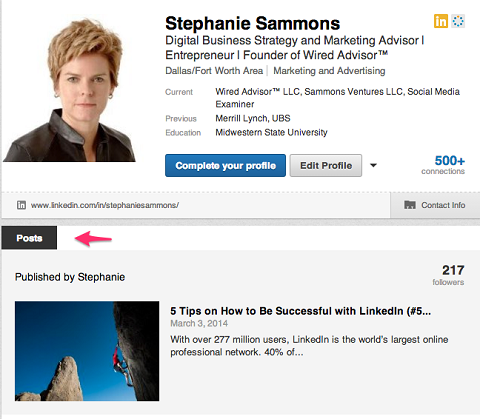
With the LinkedIn publishing platform, you can follow other publishers and build your own followers in the process. While your LinkedIn followers have the potential to see your LinkedIn posts, they aren't official network connections. (It's similar to LinkedIn's current model for following LinkedIn-appointed influencers.)
Any posts you publish on LinkedIn are tied to your professional profile and show up near the top of your profile. This means your thought leadership insights are showcased when someone views your LinkedIn profile.
The first post I published to LinkedIn helped me attract over 200 new followers, and my profile views were up 38% week over week! These stats tell me that the LinkedIn publishing platform is going to be a great place to share longer-form, thought leadership content.
In the rest of this article I give you best practices for making the most of the LinkedIn publishing platform.
#1: Create Valuable, Attractive Content
Before you start posting, have a plan in place. What content is most useful for your audience? Is your post too salesy? Although there's no formal editorial process, LinkedIn makes it clear that sales-oriented content won't be tolerated (after all, that's what the advertising platform is for).
LinkedIn has some helpful guidelines in their Help Center about what to publish. This is a good reference for understanding how to frame your content so it resonates with and adds value to both your established audience and your potential audience (which will now be even greater than your existing LinkedIn network).
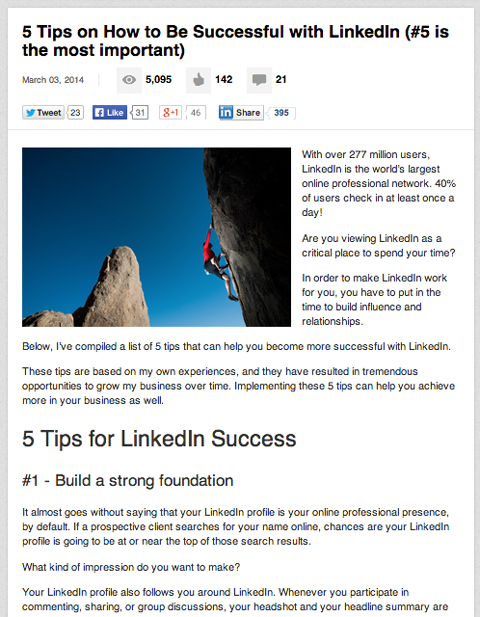
The general guidelines I've seen (including LinkedIn's) recommend keeping posts between 400 and 600 words and publishing weekly. However, you could certainly experiment with these parameters and determine what works best for you.
Get World-Class Marketing Training — All Year Long!
Are you facing doubt, uncertainty, or overwhelm? The Social Media Marketing Society can help.
Each month, you’ll receive training from trusted marketing experts, covering everything from AI to organic social marketing. When you join, you’ll also get immediate access to:
- A library of 100+ marketing trainings
- A community of like-minded marketers
- Monthly online community meetups
- Relevant news and trends updates
Like other social networks, people want to consume information quickly. Make it easy for them by creating scannable, attractive content. A few best practices are using a compelling headline, placing an eye-catching image at the top of your posts, bolding important text and breaking up longer paragraphs.
Feel free to enhance your articles with YouTube videos or content from SlideShare to make them as interesting and useful as possible.
When you're ready to write an article on the LinkedIn publishing platform, it's pretty easy. Go to your LinkedIn home page and look for the pencil icon in the box at the top where you would typically share an update.
When you click the pencil icon, you'll see the publishing editor. This is where you create your post.
LinkedIn's publishing editor is very simple to use. It's similar to the WordPress editor or Microsoft Word. You can type or paste your text into the editor and format it right there. Below is a snapshot of what my first post looks like within the editor:
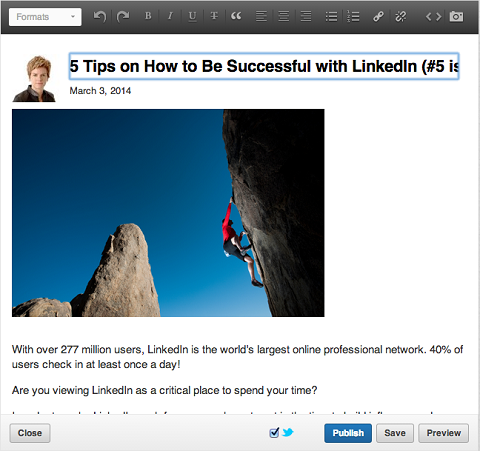
Your LinkedIn post doesn't have a bio section. You'll need to create a bio at the end of each post. Your bio should include a sentence or two about who you are, what you do and who you help, a link to your website or blog or even a specific call to action.

Discover Proven Marketing Strategies and Tips
Want to go even deeper with your marketing? Check out the Social Media Marketing Podcast! Publishing weekly since 2012, the Social Media Marketing Podcast helps you navigate the constantly changing marketing jungle, with expert interviews from marketing pros.
But don’t let the name fool you. This show is about a lot more than just social media marketing. With over 600 episodes and millions of downloads each year, this show has been a trusted source for marketers for well over a decade.
It's a good idea to make the most of all of your resources. In my bio below, I've linked my name to my Google+ profile, and on my Google+ profile I added LinkedIn to the list of sites I contribute to. This ensures that Google picks up my authorship profile for my LinkedIn posts.

Before you hit Publish, please be sure to review your post and check it for grammar and spelling (the Preview option is helpful here). But if you don't catch everything, you can go back and edit your post any time.
#2: Share Your Post Everywhere
To maximize your reach and engagement inside and outside of LinkedIn, share your post on LinkedIn, Twitter, Facebook and Google+. If you have a LinkedIn company page, share it there as well (assuming your post is relevant to your company page's followers).
This kind of aggregate social networking adds credibility and encourages more shares and engagement across the social web. In turn, all of that engagement sends social signals to Google's search algorithm and can help increase your visibility in online searches!
#3: Manage Your Post Comments
You've written a useful post, you've promoted it far and wide and people are reading it. After all that effort and exposure, don't forget to check your comments!
In the Comments section of your post, you can respond to and interact with members who are leaving feedback or starting a discussion.
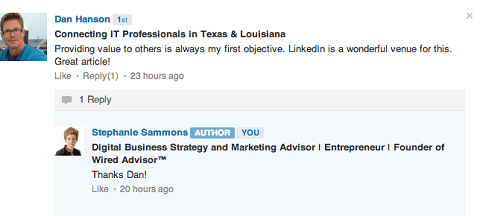
In most cases, those who commented on my posts were people I'm not currently connected to. That means the post is getting visibility beyond my first-degree network, and yours probably will too. Unfortunately I did see one or two spam comments when I posted, but you have the ability to hide and/or flag these.
#4: Evaluate Content Performance
LinkedIn immediately starts to show you the number of views, social media shares and comments your post generates. I admit that it's exciting to see those metrics changing right before your eyes in real time!
Use your LinkedIn post metrics to determine how well your content is resonating with your audience. As you build your professional content library, compare your posts to see which ones outperformed others.
When you have a feel for what's working for you, take some time to review the posts of your favorite official LinkedIn influencers and your competitors. Evaluate their posting schedule and which posts got the most views and engagement. Consider how you can use similar tactics for your own success.
For example, a LinkedIn influencer I follow is Sallie Krawcheck, CEO of 85 Broads and former head of Merrill Lynch Wealth Management. She publishes to LinkedIn about once a month.
Even though she's a prominent thought leader in the financial services industry, she writes about universal topics that appeal to a larger audience. Below is a compilation of her most recent posts. Her article about productivity hacks clearly stands out in terms of the number of views and level of engagement.
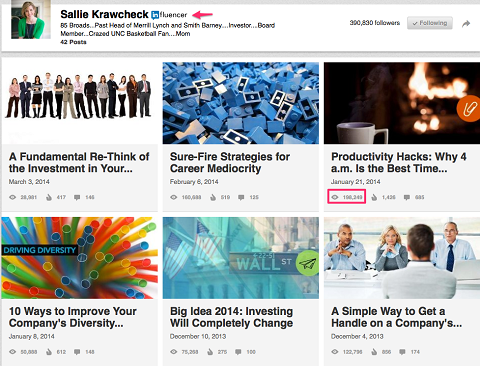
Seeing what's working gives you an idea of what people are responding to and you may want to consider using similar topics or how-to's that appeal to your own audience.
Learning from the LinkedIn influencers who have gone before you can help you craft a more successful content strategy of your own!
Keep Your Existing Blog!
It's critical to remember that LinkedIn's publishing platform shouldn't serve as your content publishing hub. It's a place to syndicate and further showcase your existing professional content from your blog.
Remember, you don't own your LinkedIn presence or the content associated with it.
I recommend publishing the original post to your own blog first, then publishing it to your LinkedIn profile in its entirety.
You may want to vary the two posts a bit, however. Perhaps write your blog post to your specific audience or niche, and when you publish it to LinkedIn, change it to appeal to a broader audience.
I'm super-excited about this publishing opportunity on LinkedIn. The LinkedIn publishing platform is an important part of any marketer's content strategy. I think it will be interesting to watch the network grow as an online content destination for professionals.
What do you think? Will the LinkedIn publishing platform be a game-changer? What kind of content are you publishing? Please share your thoughts with me in the comments below!
Attention Agency Owners, Brand Marketers, and Consultants

Introducing the Marketing Agency Show–our newest podcast designed to explore the struggles of agency marketers.
Join show host and agency owner, Brooke Sellas, as she interviews agency marketers and digs deep into their biggest challenges. Explore topics like navigating rough economic times, leveraging AI, service diversification, client acquisition, and much more.
Just pull up your favorite podcast app, search for Marketing Agency Show and start listening. Or click the button below for more information.

